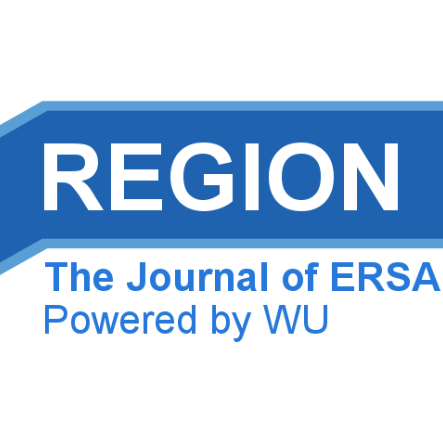A primer for working with the Spatial Interaction modeling (SpInt) module in the python spatial analysis library (PySAL)
DOI:
https://doi.org/10.18335/region.v3i2.175Abstract
This primer provides a practical guide to get started with spatial interaction modeling using the SpInt module in the python spatial analysis library (PySAL).
References
Akaike, H. (1974). A new look at the statistical model identification. Automatic Control, IEEE Transactions on, 19(6):716–723.
Cameron, A. C. and Trivedi, P. K. (2013). Regression Analysis of Count Data. Cambridge University Press, New York.
Chun, Y. (2008). Modeling network autocorrelation within migration flows by eigenvector spatial filtering. Journal of Geographical Systems, 10(4):317–344.
Dennett, A. (2012). Estimating flows between geographical locations:‘get me started in’spatial interaction modelling. Working Paper 184, Citeseer, UCL.
Flowerdew, R. and Aitkin, M. (1982). A Method of Fitting the Gravity Model Based on the Poisson Distribution. Journal of Regional Science, 22(2):191–202.
Flowerdew, R. and Lovett, A. (1988). Fitting Constrained Poisson Regression Models to Interurban Migration Flows. Geographical Analysis, 20(4):297–307.
Fotheringham, A. S. (1983). A new set of spatial-interaction models: the theory of competing destinations. Environment and Planning A, 15(1):15–36.
Fotheringham, A. S. and Brunsdon, C. (1999). Local Forms of Spatial Analysis. Geographical Anal- ysis, 31(4):340–358.
Fotheringham, A. S. and O’Kelly, M. E. (1989). Spatial Interaction Models:Formulations and Applica- tions. Kluwer Academic Publishers, London.
Knudsen, D. and Fotheringham, A. (1986). Matrix comparison, Goodness-of-fit, and spatial inter- action modeling. International Regional Science Review, 10:127–147.
Kordi, M., Kaiser, C., and Fotheringham, A. S. (2012). A possible solution for the centroid-to- centroid and intra-zonal trip length problems. In International Conference on Geographic Informa- tion Science, Avignon.
Lenormand, M., Huet, S., Gargiulo, F., and Deffuant, G. (2012). A Universal Model of Commuting Networks. PLoS ONE, 7(10):e45985.
LeSage, J. P. and Pace, R. K. (2008). Spatial Econometric Modeling Of Origin-Destination Flows. Journal of Regional Science, 48(5):941–967.
Masucci, A. P., Serras, J., Johansson, A., and Batty, M. (2012). Gravity vs radiation model: on the importance of scale and heterogeneity in commuting flows. arXiv:1206.5735 [physics]. arXiv: 1206.5735.
McFadden, D. (1974). Conditional logit analysis of qualitative choice behavior. In Frontiers in Econometrics, pages 105–142. Academic Press, New York.
Nelder, J. A. and Wedderburn, R. W. M. (1972). Generalized Linear Models. Journal of the Royal Statistical Society. Series A (General), 135(3):370–384.
Tiefelsdorf, M. and Boots, B. (1995). The specification of constrained interaction models using the SPSS loglinear procedure. Geographical Systems, 2:21–38.
Tsutsumi, M. and Tamesue, K. (2011). Intraregional Flow Problem in Spatial Econometric Model for Origin-destination Flows. Procedia - Social and Behavioral Sciences, 21:184–192.
Wedderburn, R. W. M. (1974). Quasi-Likelihood Functions, Generalized Linear Models, and the Gauss-Newton Method. Biometrika, 61(3):439–447.
Wilson, A. G. (1971). A family of spatial interaction models, and associated developments. Envi- ronment and Planning A, 3:1–32.
Yan, X.-Y., Zhao, C., Fan, Y., Di, Z., and Wang, W.-X. (2013). Universal Predictability of Mobility Patterns in Cities. arXiv:1307.7502 [physics]. arXiv: 1307.7502.
Downloads
Published
How to Cite
Issue
Section
License
REGION is an open journal, and uses the standard Creative Commons license: Copyright We want authors to retain the maximum control over their work consistent with the first goal. For this reason, authors who publish in REGION will release their articles under the Creative Commons Attribution license. This license allows anyone to copy and distribute the article provided that appropriate attribution is given to REGION and the authors. For details of the rights authors grant users of their work, see the "human-readable summary" of the license, with a link to the full license. (Note that "you" refers to a user, not an author, in the summary.) Upon submission, the authors agree that the following three items are true: 1) The manuscript named above: a) represents valid work and neither it nor any other that I have written with substantially similar content has been published before in any form except as a preprint, b) is not concurrently submitted to another publication, and c) does not infringe anyone’s copyright. The Author(s) holds ERSA, WU, REGION, and the Editors of REGION harmless against all copyright claims. d) I have, or a coauthor has, had sufficient access to the data to verify the manuscript’s scientific integrity. 2) If asked, I will provide or fully cooperate in providing the data on which the manuscript is based so the editors or their assignees can examine it (where possible) 3) For papers with more than one author, I as the submitter have the permission of the coauthors to submit this work, and all authors agree that the corresponding author will be the main correspondent with the editorial office, and review the edited manuscript and proof. If there is only one author, I will be the corresponding author and agree to handle these responsibilities.




